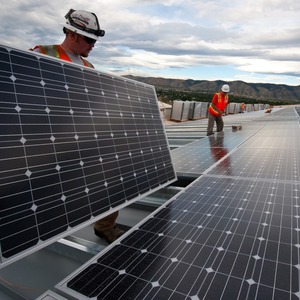
For those not steeped in the field of chemistry, what follows is a quick-and-dirty rundown of how solar panels turn sunlight into electricity.
“Think of a solar cell as an LED in reverse,” explained Steffen Eikenberry, a researcher at the Arizona State University School of Mathematical and Statistical Sciences, during an hour-long phone interview. With the patience of a teacher explaining things to a C student, Dr. Eikenberry helped me gain a more complete understanding of how solar cells convert sunrays into energy.
The diode in the LED is analogous to the two layers of silicon crystals in the solar cell. Except in a solar cell, the two layers of the diode are silicon, one on top and the other underneath. To generate an electrical current, these layers of silicon are treated through a chemical process called “doping” that causes an electron imbalance. In trying to achieve balance, the resulting electron dance becomes what we call an electrical current.
The top layer of silicon (exposed to the sun) is doped with phosphorus and the bottom layer with boron. Phosphorous has an extra electron, while boron is missing one. Electrons like to achieve stability in even pairs. Stable elements, such as argon, have even pairs. Unstable elements do not, but they seek to establish balance by sharing electrons with complementary elements. In a silicon wafer, electrons achieve equilibrium by pairing up in a matrix of shared electrons—or what we might call a crystal lattice (think snowflakes). But a photon, or a particle of light, precisely aimed and with just the right amount of energy, can knock a single silicon electron right out of its resting place.
When sunlight strikes the top layer of the silicon cell, particles of light, or photons, dislodge electrons from the crystal lattice. Were it not…
Weekly Newsletter
Get building science and energy efficiency advice, plus special offers, in your inbox.

This article is only available to GBA Prime Members
Sign up for a free trial and get instant access to this article as well as GBA’s complete library of premium articles and construction details.
Start Free TrialAlready a member? Log in















2 Comments
That's a nice intuitive explanation!
(Note to the editors: silicon, with no e, is the element and the material used in PV cells. Silicone with an e is the rubber-like polymer used in caulks, gaskets, etc.)
Thanks, Charlie--I made that correction, and am glad for the information.
Log in or become a member to post a comment.
Sign up Log in